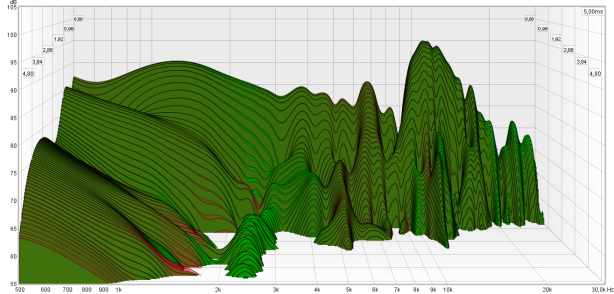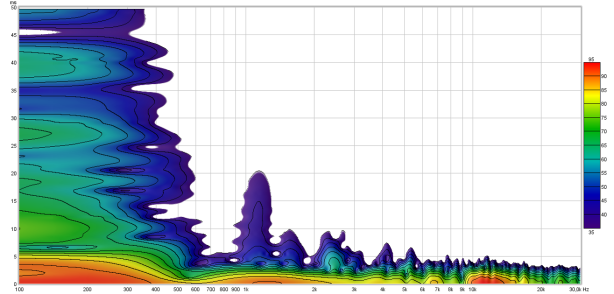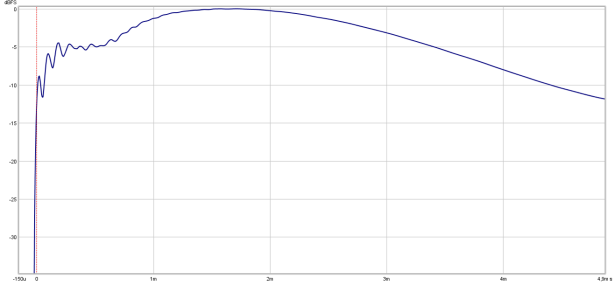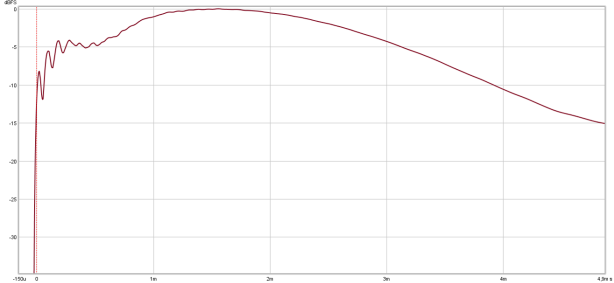Crossfade M100
back to V-MODA
back to measurements
home
published: Jul-8-2017
NO SMOOTHING is applied to the shown plots. Most measurement sites have some smoothing applied which ‘irons flat’ sharp peaks and ‘wiggles’. I do not use smoothing because some info about sound quality is lost when plots are smoothed.
Aside from a small correction of the microphone itself also some correction in the lowest frequencies is applied to the plots to compensate for the perceived loss of bass when using headphones. This is described HERE in more detail.
A ‘horizontal‘ frequency response curve on the shown frequency response plots on this website thus indicates a perceived ‘flat’ tonal signature.
ALL measurements are made with a good SEAL on a flatbed measurement rig.
The shape of your head, bone structure, pad size, pad ‘softness, (compliance), hair or no hair and or wearing glasses may (drastically) change the frequency response of some headphones, so… your personal experience may differ substantially from these plots.
Frequency response (tonal balance) is the most sound-determining aspect of headphones. A horizontal line shows audible neutral response in the plots on this website. Deviations in different severities at different frequency bands have an effect on the sound character.
The bigger the deviation the stronger the effect.
Below an aid to help determining the sound character of headphones with relation to the frequency response.

V-MODA Crossfade M100

The V-MODA Crossfade M100 is a closed dynamic headphone. The build quality is high and is designed to be used in portable applications mainly.
It retails for around €220.- in Europe. It is highly customizable which is well received by many. The headphones look small yet it certainly is not. The pads are replaceable and most people agree the XL memory foam pads make for a better and more comfortable fit.
These headphones are known for their huge bass … and that they deliver. It should satisfy bassheads.
specifications:
Type: Over ear, closed
Usage: Portable, commuting, office and home.
Driver type: dynamic, Dual Diaphragm
Pads: pleather (fake leather)
Foldable: Yes
Headphone connector: 3.5mm TRS
Cable entry: single sided entry (+ sealing plug) or dual sided
Cable: 1.3m screw-able 3.5mm TRS (+ screw-on 6.3mm adapter) to 3.5mm TRS plug
Driver size: 50mm
Max power rating: unknown
Max. S.P.L.: unknown
Impedance: 32Ω
Efficiency: 103dB @ 1mW
Sensitivity: 118dB @ 1V
Weight: 280g.
Clamping force: medium/high
Accessories: Hard carrying case, 6.3mm screw-on adapter, Carabiner clip, 2x plug sealer, 1x stereo cable and 1 cable with mic/remote.
Measurements:
Below the frequency response of the closed M100 (Left, Right)

The frequency response is far from flat (neutral). When looking for a hi-fi headphone you need to look elsewhere. The boosted bass is obvious. +10dB opposite the mids. +10dB is perceived as a doubling of loudness so the bass is twice as loud as the rest !
The dip around 500Hz ensures that the bass and lows are somewhat dis-attached from the rest and prevents the sound to become ‘bloated’ and ‘congested’.
The mids have something weird to them. From 300Hz it goes down and them up again to 1kHz and slopes down again to 10kHz. The mids are forward/present but are slightly lacking in clarity as well. The treble quality is not super high. It lacks treble extension and finer nuances. It also has boosted treble around 11kHz which can make some recordings to show a bit of a sharp ‘edge’.
output resistance / damping-factor
As this is a low impedance (32Ω) dynamic headphone the frequency response in some headphones changes when used with a higher output resistance (desktop) amplifier.
To test this the headphone is measured via a low impedance amplifier (0.2Ω) and a high impedance amplifier (120Ω). On a higher output resistance amplifier the output level will be considerably lower. To compensate for this the amplifier is cranked up to the same level (at 1kHz) as the low impedance amplifier. This way the plots are overlay-ed and it is easy to see how the tonal balance changes.
Right channel only, driven from 0.2Ω and 120Ω amplifier.
As can be seen the difference is negligible over the entire frequency range. This headphone thus totally relies on mechanical damping and is not affected by a low damping factor (high output resistance of an amplifier). Basically it is not picky with amplifiers.
Below the distortion plots of the M100: (only Right channel shown)
The distortion products are shown in dB.

Note that this headphone was measured at ![]() where unavoidable background noises were present in the demo room. Distortion levels and spectrum plot performance may thus be better in reality than shown on the plots.
where unavoidable background noises were present in the demo room. Distortion levels and spectrum plot performance may thus be better in reality than shown on the plots.
Below the same plot except shown in percentages.

The distortion is (pleasantly) surprising low for a dynamic driver. The distortion in the bass remains below 1% which is excellent. Above 300Hz, where distortion becomes audible as a sound degrading thing the 2nd harmonic distortion is around 0.1%. The more nasty distortion is well below that so very nice numbers here.
Below the CSD of the M100 (Left and Right channel are superimposed)
 Aside from some short-lived ringing at around 2.5kHz, 5kHz and 11kHz there is not much to worry about. Not an exemplary performance though but also not worrying.
Aside from some short-lived ringing at around 2.5kHz, 5kHz and 11kHz there is not much to worry about. Not an exemplary performance though but also not worrying.

Above the CSD of the M100 (right channel) via a 0.2Ω output resistance amplifier and also when connected to a 120Ω amplifier.
A higher output resistance (poor dampingfactor) doesn’t change the sound nor decay.
Below the spectrum plot of the M100. (Right channel)

There is a small ringing visible around 1.2kHz, 2.5kHz and a shorter one at 5kHz. This plot is looks pretty much O.K. No deal-breaking resonances.
By lack of oscilloscope shots (not enough time to measure that) below a step response plot of the M100. (Left channel)

The (mid)bass boost is clearly visible. There is also some ringing visible.
The step response shows this is not a hi-fi headphone with a realistic sound but rather has a bassy and ‘fun’ nature.
Below the Right channel.

summary
The M100 is not a headphone that measures well. It does have some small issues as shown in the measurements but the audibility of those remains to be seen.
The sonic character is great for listening to pop and rock etc on the go directly from your phone in noisy environments (commuting etc) The boosted bass and treble peak can really help to make the sound more pleasant.
For Hi-Fi and home usage this headphone should probably be avoided. The better recordings will sound boomy and ‘fat’ and far from realistic.
This headphone serves a purpose.
Those looking for a highly customizable and well supported and high quality fashionable headphone for on the go while playing crappy music files from your phone will have a very enjoyable experience and look good on the side as well.
You will have to love da bassss from this headphone. That’s what this is headphone is mostly about (and its looks).
